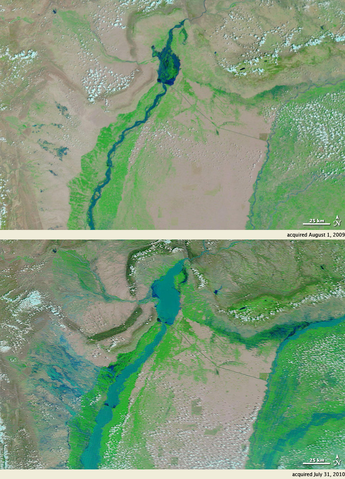 |
This is a file from the Wikimedia Commons. Information from its description page there is shown below.
Commons is a freely licensed media file repository. You can help.
|
Summary
| DescriptionPakistan Indus flooding July 2010 - MODIS.png |
English: Monsoon rains fall in Pakistan every summer, but the rains beginning in late July 2010 were unusually heavy. By August 1, 2010, entire villages were washed away, more than 1,100 people had died, and an estimated 2.5 million people were affected, according to news reports. A shortage of safe drinking water and a possible outbreak of cholera were among the most pressing dangers. The Moderate Resolution Imaging Spectroradiometer ( MODIS) on NASA’s Terra satellite captured these images on July 31, 2010 (bottom), and August 1, 2009 (top). These images show the Indus River in northwestern Pakistan. Both images use a combination of infrared and visible light to increase the contrast between water and land. Water varies in color from electric blue to navy. Vegetation is green and bare ground is pinkish brown. Clouds range in colour from nearly white to pale blue-green.
Acquired at the same time of year, the images show the dramatic difference caused by torrential monsoon rains. Flowing roughly north-south the Indus River appears as a braided stream in 2009, with patches of dry or nearly dry ground in the river valley. In 2010, the water level is high enough to cover areas that were dry the previous year. West of the river, long tendrils of standing water extend toward the northwest. Water levels are also significantly higher in tributaries east of the Indus River.
Officials described the flooding in northwestern Pakistan as the worst since 1929. News reports documented some 30,000 residents stranded on rooftops, and some 65 bridges completely washed away. As governments and international aid organizations struggled to assist the flood victims, weather officials forecast more monsoon rains starting August 2, 2010. MODIS provides daily images, where clouds permit, that enable responders to assess flood conditions over a wide area in a single satellite pass. The MODIS Rapid Response Team provides daily images of this region.
|
| Date |
3 August 2010 |
| Source |
NASA Earth Observatory |
| Author |
MODIS Rapid Response Team |
Licensing
| Public domainPublic domainfalsefalse |
 |
This file is in the public domain because it was solely created by NASA. NASA copyright policy states that "NASA material is not protected by copyright unless noted". (See Template:PD-USGov, NASA copyright policy page or JPL Image Use Policy.) |
|
|
|
Warnings:
- Use of NASA logos, insignia and emblems are restricted per US law 14 CFR 1221.
- The NASA website hosts a large number of images from the Soviet/ Russian space agency, and other non-American space agencies. These are not necessarily in the public domain.
- Materials based on Hubble Space Telescope data may be copyrighted if they are not explicitly produced by the STScI. See also {{ PD-Hubble}} and {{ Cc-Hubble}}.
- The SOHO (ESA & NASA) joint project implies that all materials created by its probe are copyrighted and require permission for commercial non-educational use.
- Images featured on the Astronomy Picture of the Day (APOD) web site may be copyrighted.
|
File usage
The following pages on Schools Wikipedia link to this image (list may be incomplete):
Wikipedia for Schools was collected by SOS Children. SOS Childrens Villages helps more than 2 million people across 133 countries around the world. You can help by sponsoring a child.





